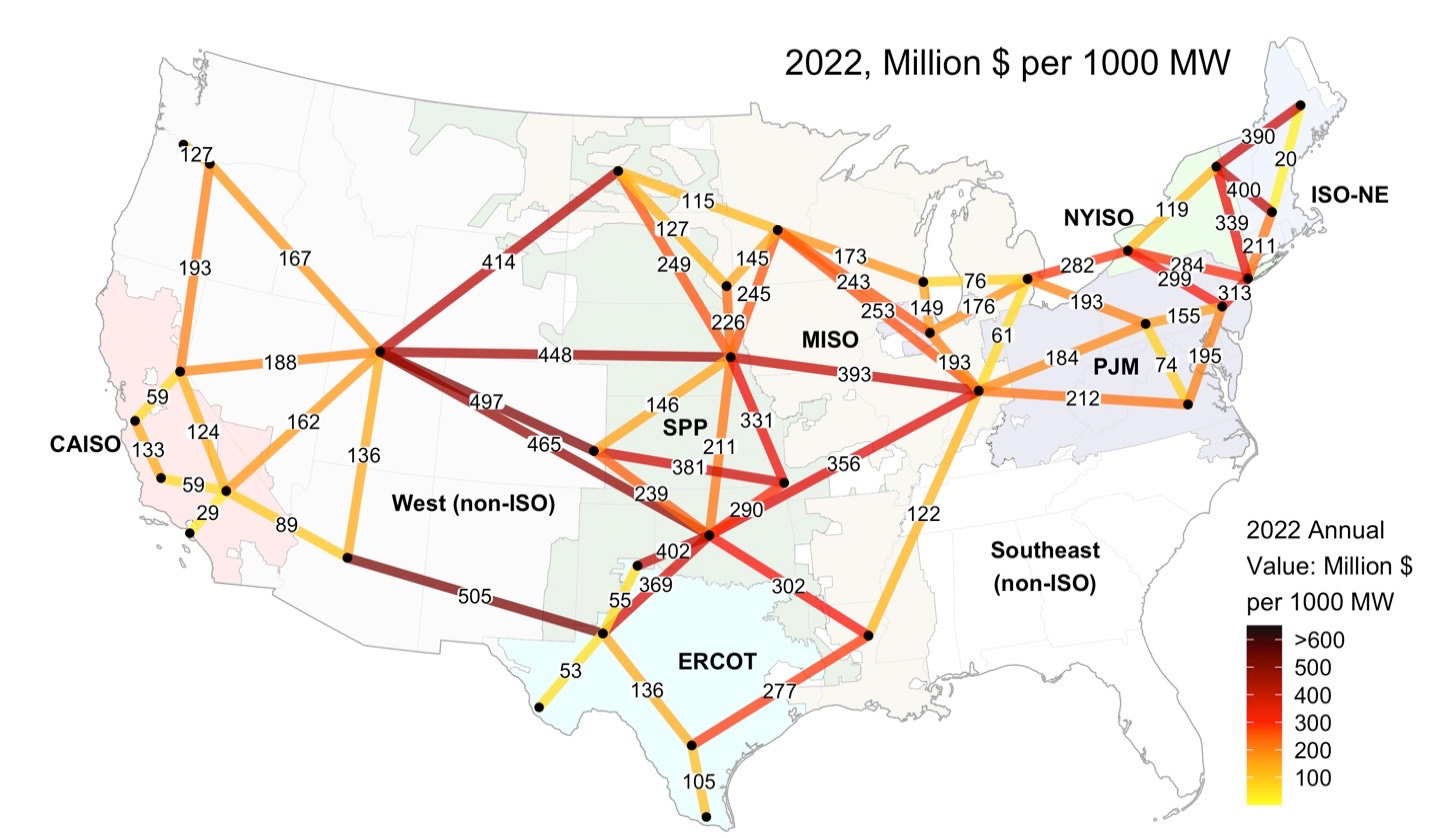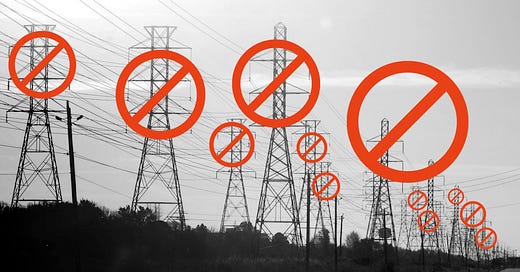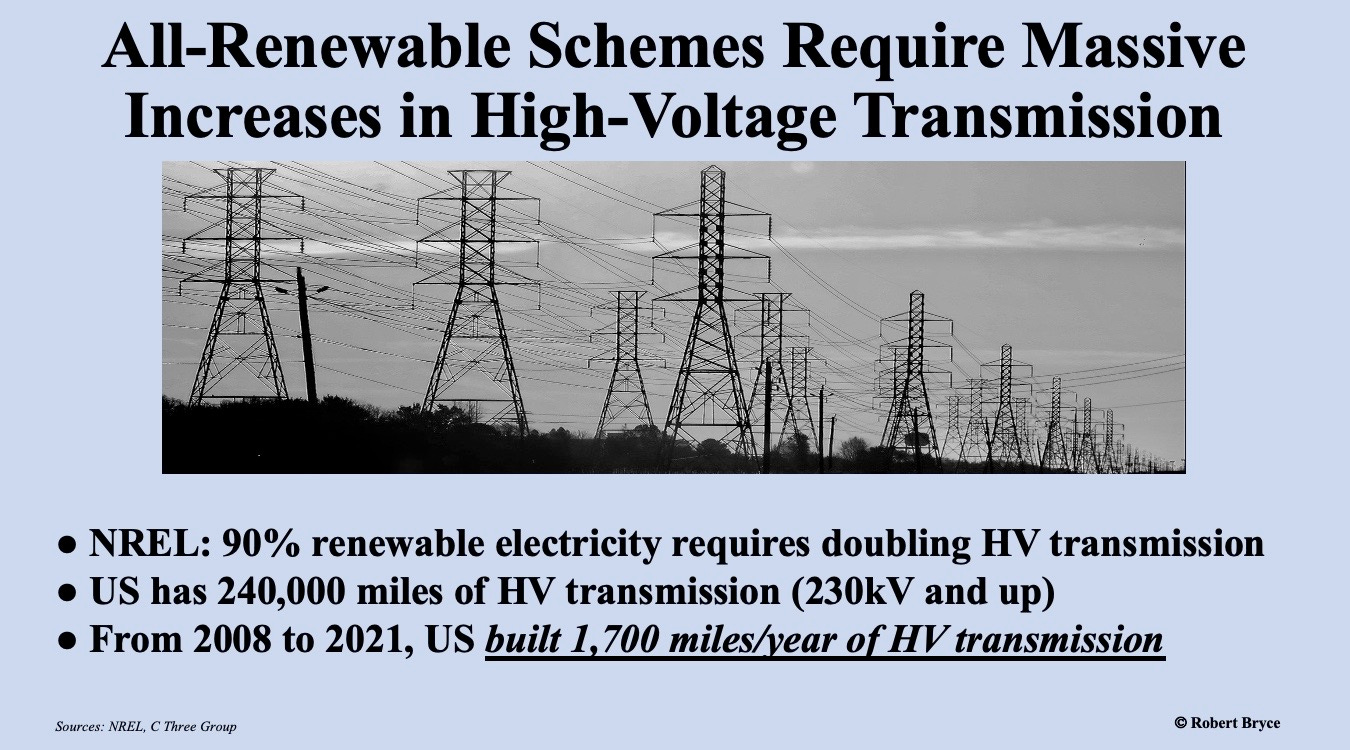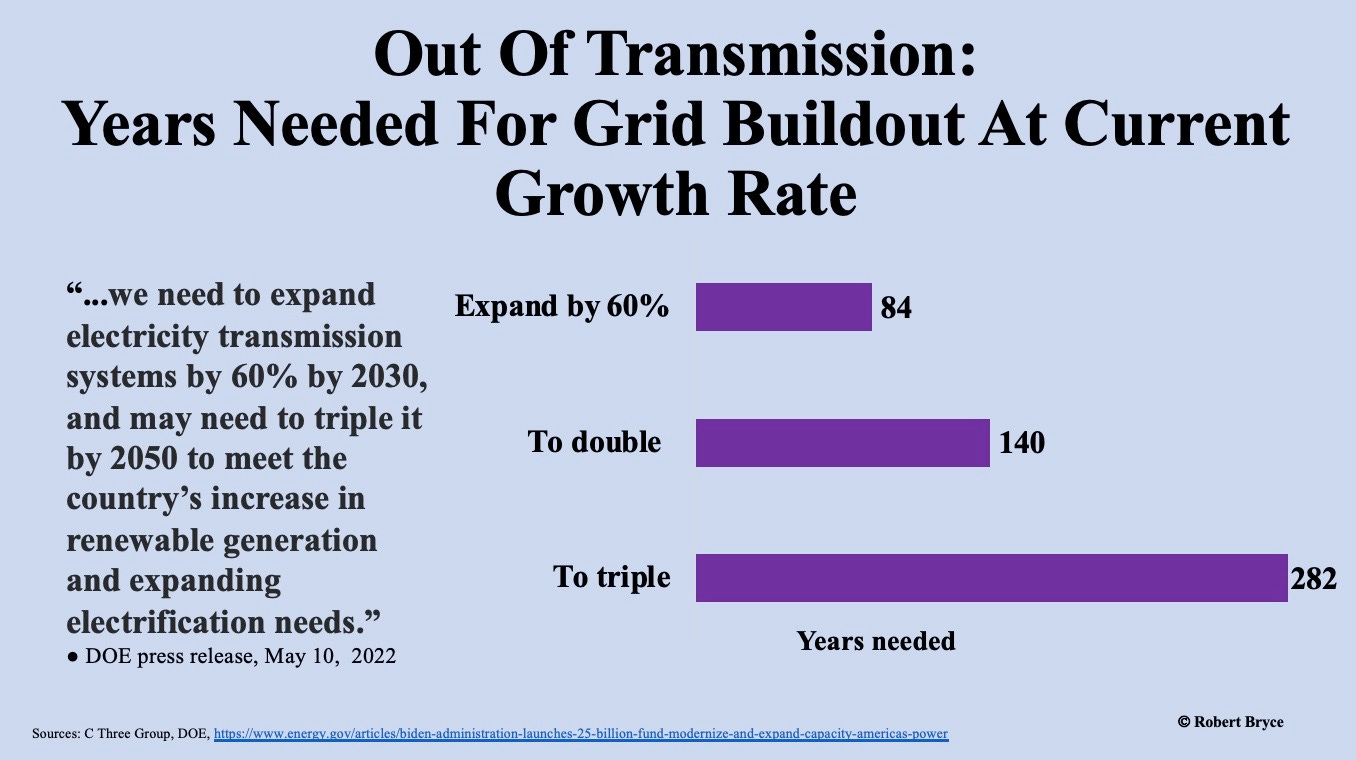Out Of Transmission
Want to double the size of our transmission grid? At current growth rates, it’ll only take about 140 years!
Billionaires, bureaucrats, and academics claim that shifting to an all-renewable electricity system will require doubling or tripling the size of our high-voltage transmission grid. Talking about it is easy. Making it happen? That’s an entirely different story.
Last month, Michael Bloomberg, the New York-based mega-billionaire wrote an article for his news outlet that was headlined “Winter Blackouts Highlight Need For Clean Energy.” In the article, Bloomberg, who is giving $500 million to the Beyond Carbon project through his charity Bloomberg Philanthropies, claimed that our electric grid should rely more on weather-dependent renewables because “renewable energy has advantages over coal and gas in severe weather.”
The former mayor of New York went on, claiming that in addition to better batteries, the U.S. needs to build “the long-distance transmission lines” needed to carry more wind and solar energy. “When Chicago’s HVAC systems are kicking in, solar panels in the Southwest are reaching their maximum. We just need more high-speed wires to connect the two regions.” Set aside the silliness of “high-speed wires” (does electricity ever use “slow-speed wires”?) and focus on his key claim: “the faster we build transmission capacity...the healthier and safer our families and communities will be.”
In 2021, another billionaire, John Doerr, who like Bloomberg, is giving climate activist groups hundreds of millions of dollars (see my January 26, article “The Billionaires Behind The Gas Bans”) made a similar claim about the need for a massive expansion of the high-voltage transmission system. In his book Speed & Scale: An Action Plan for Solving Our Climate Crisis Now, Doerr lays out what he calls “Key Emission Reduction Policies” (page 333) including a clean electricity standard that could, in theory anyway, cut emissions by at least 50% by 2025 and 100% by 2040. In what amounts to a footnote, Doerr explains that his modeling assumes “a doubling of the transmission system above business as usual.”
Bureaucrats are on board, too. Last May, the Biden administration announced a $2.5 billion fund that will help support the buildout of the nation’s high-voltage transmission system. In a press release, the Department of Energy said that “Independent estimates indicate that we need to expand electricity transmission systems by 60% by 2030, and may need to triple it by 2050 to meet the country’s increase in renewable generation and expanding electrification needs.”
That DOE press release appears to be referring to the massively hyped Net Zero America report, released in late 2020 by a group of academics at Princeton University. In one scenario, they claim that the U.S. could deploy staggering amounts of wind capacity (covering most of Missouri and eastern Iowa with wind turbines) and that to accommodate that much capacity, the U.S. will need to have a transmission capacity that is 3.2 times larger than the existing system by 2050.

Or consider a document published on Tuesday by Lawrence Berkeley National Lab which claimed that in 2022, “additional transmission could have reduced electricity system costs by more than in any year from 2012 to 2021.” The document includes a map (see above) with an overlay of a theoretical high-voltage system and how many millions of dollars it might save per 1,000 megawatts of transmission capacity. But the word “miles” doesn’t appear anywhere in the analysis. There’s no recognition that all that new transmission capacity has a physical footprint that will have to be quantified, mapped, and constructed. Instead, the authors of the report—at least two of whom are PhDs—explain that the focus of the “factsheet is the simple concept that transmission enables a lower cost set of generators to meet load than would otherwise be available.”
To that, my rather non-technical reply is: “no shit, professor.”
The problem with all of these claims and reports from the billionaires, bureaucrats, academics, and the elites working at our national laboratories, is that not one of them bothered to analyze how feasible their plans are or how their expansion schemes might actually work in the physical world. There’s not a single mention (or even a thought given) to the friction their plans might face from rural towns and counties. Not one of them bothered to do any comparisons about how much high-voltage capacity is being built every year in the United States or how long it might take to achieve the expansions they are envisioning.
Here’s the reality: the surge in land-use conflicts facing wind and solar projects across the country, a backlash I have documented in the newly updated Renewable Rejection Database (which is now searchable)––combined with the widespread opposition in rural America to high-voltage transmission projects––shows that such a massive expansion of the grid will not happen.
The numbers—and the history—do not lie. Let’s talk about the numbers first.
In 2012, the National Renewable Energy Laboratory estimated that if the U.S. were to attempt to derive 90% of its electricity from renewable sources, it would have to roughly double its high-voltage transmission capacity. The US now has about 240,000 miles of high-voltage transmission lines. Put another way, trying to run the electric grid on renewables would require enough high-voltage transmission to circle the Earth nearly 10 times.
Last year, I contacted Jean Reaves Rollins, the president of the Atlanta-based consulting firm C Three Group, which tracks the growth of energy infrastructure across the U.S. I asked her to provide numbers for the growth of America’s high-voltage (230kV and above) transmission system since 2008. Rollins and her team graciously provided me with the data. The numbers are sobering.
Between 2008 and 2021, according to C Three Group, the U.S. high-voltage transmission system grew by about 1,700 miles per year. Thus, at current rates of growth, doubling the size of America’s high-voltage transmission grid will take about 140 years!
And recall, that the 1,700 miles per year of growth on the grid includes intrastate and interstate projects. Rollins and her team also provided figures for the growth of interstate high-voltage transmission. Those numbers are even more sobering. Between 2008 and 2021, the U.S. only added about 217 miles per year of interstate high-voltage transmission capacity. That means that the map from Lawrence Berkeley Lab showing continent-spanning transmission systems is nothing more than wishful thinking.
Rollins and her team also provided cost figures. Between 2008 and 2021, each new mile of high-voltage transmission capacity cost about $4 million. Thus, if those figures stay flat and the U.S. attempted to double its high-voltage transmission capacity, the cost to consumers would be about $1 trillion. But inflation and other factors will undoubtedly mean significantly higher costs. For instance, in California, the Tehachapi Renewable Transmission Project, which moves electricity from renewable generators in Kern County south to San Bernadino County, cost about $2 billion for a project that spans 173 miles, resulting in a cost of about $11 million per mile. Thus, attempting to double the size of our electric grid could cost $2 trillion, or even more.
But the cost figures may not be as important as the history of high-voltage transmission projects across the country––a history that is littered with the corpses of canceled and delayed projects. There are dozens of examples of the rural backlash against these projects. I’ll provide just a few of them.
In 2017, Iowa enacted a law prohibiting the use of eminent domain for high-voltage transmission lines. The move doomed the Rock Island Clean Line, a 500-mile, $2 billion, direct-current transmission line that aimed to carry electricity from Iowa to Illinois. The opposition forced the project’s developer, Houston-based Clean Line Energy Partners, to withdraw its application for the project in Iowa.
In early 2018, Clean Line Energy Partners announced it was suspending its years-long effort to build a 720-mile, $2.5 billion transmission line across the state of Arkansas. The Plains & Eastern Clean Line aimed to carry wind energy from Oklahoma to customers in the southern and southeastern US. But the project faced fierce opposition in Arkansas where the state’s entire Congressional delegation opposed the deal.
Also in 2018, New Hampshire regulators rejected a high-voltage electricity transmission project called Northern Pass Transmission that was to carry power from Quebec hydroelectric facilities to consumers in Massachusetts. But the 192-mile, $1.6 billion project––which was to go through New Hampshire’s White Mountains––was vetoed in a unanimous vote by the New Hampshire Site Evaluation Committee.
A similar high-voltage project, the $2.3 billion, 780-mile Grain Belt Express, has been delayed for years by opposition from rural residents in Missouri and other states. First proposed in 2010, the 4,000-megawatt project is designed to move electricity from Kansas to Indiana and other states. But in 2015, the Missouri Public Service Commission blocked the project after concluding the cost to the state’s landowners exceeded its benefits. The fight over the project was partially resolved in mid-2018 when the Missouri Supreme Court ruled in favor of the transmission line. But the project is still facing permitting hurdles in Kansas, Missouri, and Illinois. Last month, an Illinois state legislator, Adam Neimerg, declared that the Grain Belt Express “does nothing to benefit the folks, energy-wise, here in the state of Illinois. So it takes property rights away from many folks.”
In addition, there are numerous examples of the long lead times involved in building transmission projects. For instance, the TransWest Express project aims to move wind energy from Wyoming to Utah, Nevada, and California. That project has been in development since 2005 but it still hasn’t begun construction. The project is owned by Denver-based billionaire Philip Anschutz’s The Anschutz Corporation. As I reported here last week, Anschutz’s Power Company of Wyoming is developing the giant Chokecherry and Sierra Madre wind project. It needs the TransWest project to carry the electricity from Wyoming to customers further west. The project is still waiting for final permits from the Bureau of Land Management. On its website, TransWest says it expects to begin construction sometime this year and finish the project in 2026. Thus, from start to finish (if it happens at all) the TransWest project will take more than two decades!
I could provide many other examples of the delays and cancellations of transmission projects. But the punchline is obvious: despite the never-ending hype about renewable energy, there is simply no way that the U.S. will be able to double (or triple) the amount of high-voltage transmission capacity needed to accommodate all of the envisioned wind and solar projects on any time frame that makes sense.
That leads to another equally obvious point: the electric grid we have today––that is, the poles, transformers, towers, wires, arresters, and other kit needed to move electricity from power plants to consumers––will look a lot like the grid we will have tomorrow, and next year, and for the next two or three decades. Given these facts, smart policymakers and utilities should be looking at ways to utilize the existing grid by putting new, low- or zero-carbon generation plants in locations that already have access to high-voltage transmission.
Some companies are considering that strategy. Last October, TerraPower, which is developing a small modular reactor, announced that it has begun a study to evaluate deploying its Natrium reactor at five coal plants that are now operated by PacifiCorp, which is owned by the mega-conglomerate, Berkshire Hathaway. The study, according to PacifiCorp’s press release, will evaluate, among other things, the repurposing of “existing generation and transmission assets for the benefit of” the company’s customers.
Last September, the Department of Energy released a report which found that “80% of retired and operating coal power plant sites that were evaluated have the basic characteristics needed to be considered amenable to host an advanced nuclear reactor.” It is no surprise that the report is filled with references to the high-voltage transmission system and the fact that new nuclear plants “could use the existing transmission, transportation, and water infrastructure left behind from retired coal plants.”
It took more than a century for us to build our electric grid. It is the Mother Network, the network upon which all of our most-critical networks depend. If we are going to be serious about cutting greenhouse gas emissions, we need to give up on the all-renewable mirage. We need to accept the physical limitations of the electric grid we have, and get serious about adding more nuclear energy to our power mix by putting new, smaller, safer, cheaper nuclear reactors in places where generators are currently burning hydrocarbons.







Another aspect of the expansion needed, is all those solar panels on houses feeding into the grid. All those EV's backfeeding into the grid (under some proposals). These will work at what is called in the industry the distribution level (generally 69kv and lower). In fact the stuff running by your house is generally around 13kv, but I digress. My point is, the distribution level was not, is still not, designed for "back feeding" into the system. It was designed to deliver one way. It has been able to take minor back feeding ...say 3% of power (if that). That's ok, but under some of proposals...30% or more (at times of high demand) its not designed for. Nor is it easily modified for such power flows. Also, the back office accounting for such "back feeding" needs to be upgraded from current practice (ie. Net metering a'nt gonna work). Also such large #'s of relatively small power generators need to be tightly/quickly controlled by the local/regional utility so that voltage/frequency problems are kept to nominal levels. This again goes back to how the original grid design was for the economies of large centralized power plants.
Great essay, thank you. Very informative about the challenge of going “full” renewables and its impact on transmission lines. I am sure there is an equally bizarre analysis on storage capacity for renewables as well. Two issues we never hear about from the propaganda machine.
The challenge: public utilities are loosing profits (which are reinvested into The Grid) from power generated from carbon that is being replaced with renewables (which are not produced by the public utilities). Putting The Grid at risk. Somehow this needs to be figured into our “transition” from the past to the future state. And nuclear is the wild card here. IMO, the US needs to model itself after France, which gets 70% of its power from nuclear. I’ll never buy an EV unless I can charge it with electricity generated from nuclear.